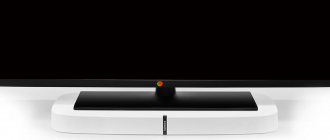Television in people's lives
Even during the Soviet period, everything that was shown on TV was strictly filtered. It was thanks to this that it was possible to easily influence people’s worldviews. Now there is other propaganda. Nowadays, advertisers and psychologists have come up with more subtle methods of processing a person. Information is now given little by little, without any pressure. It acts on the subconscious. On TV they impose not only political views, but also create an ideal world. As a result, we understand that our relationship is not as wonderful as in the movies. Not everything in the house is as good as it seemed. And the work could have been better.
Advertisers create a need (artificial) in a person for a particular product. As a result, you end up with a lot of unnecessary items at home.
So, we come to the most important thing, what are the known pros and cons of TV for a person. Based on the positive and negative effects of this activity, it will be possible to make the right decision about whether you need to watch TV at all
Dolby vs DTS
Half the success of a good film is its soundtrack. The two most popular audio formats are DTS and Dolby . Both support six-channel surround sound (a five-speaker system with a subwoofer). The main difference between them is the bitrate. For example, for Blu-ray discs, Dolby technology compresses audio to 640 Kbps, while DTS bitrates are up to 1.5 Mbps. In theory, less compression during encoding means more detailed audio. So, let's choose DTS? Not so fast. Dolby claims that its codecs and compression algorithms are more efficient, and the sound is not inferior to its competitor. However, modern TVs often have both technologies at the same time.
The most advanced versions of these audio formats are DTS:X and Dolby Atmos . They support eight-channel (7.1) surround sound, and therefore more accurately and realistically recreate various sound effects (for example, the noise of a helicopter flying overhead or the flight of a bullet).
Dolby Atmos uses additional speakers. Ideally, they are placed on the ceiling to create a sound “bubble”. Don't want to drill into the ceiling with a hammer drill? You can buy Dolby Atmos sound bars with special drivers that create a similar effect. Premium models from all well-known manufacturers have Dolby Atmos support. This format is found on Blu-ray Discs and streaming services including Amazon Prime Video and Netflix.
DTS:X is more flexible. It works with standard driver settings and does not require additional speakers. You can manually adjust audio tracks, allowing you to, for example, bring out an actor's voice above loud special effects. DTS:X support can be added by the TV manufacturer through a firmware update. In terms of content, it's a less common format: neither Netflix nor AppleTV+ currently support it.
With rare exceptions, modern TVs cannot boast of powerful acoustics, so movie buffs should consider purchasing a good additional audio system. These could be regular speakers, a sound bar or a home theater.
Easy access to information
Considering the pros and cons of a computer and TV, it is worth saying that these devices provide easy access to information. Of course, a person should not be aware of everything that happens in the world. Yes, this is basically impossible. That's why news programs exist. Thanks to them you can find out news from different parts of the world. Further we can say that the plus turns into a minus. There is a lot of information being presented, but what is true and what is false is difficult to understand. Therefore, you need to be able to distinguish one from the other.
1) HDMI connection
The HDMI port is the most preferred port for connecting a TV to a computer.
It allows you to transmit high-resolution video (up to 3840x2160 pixels) and multi-channel audio over one cable. Often among the TV interfaces there are 2-3 HDMI connectors, which makes it possible to connect several devices to it simultaneously (for example, a game console).
The only couple of disadvantages of an HDMI connection are the limited cable length (up to 10 m) and its high cost.
A virtual reality
We have already looked at the advantages of TV. We will now consider the disadvantages further. Everything you watch on TV (be it TV series, news or cartoons) has an impact. This is the negative impact. By watching TV, a person simply runs away from real life, not wanting to decide anything in it.
It’s very bad if watching TV causes you not only bad thoughts, but also anger. After all, TV often shows a rich life. This dissatisfaction can even lead to depression.
Harmful factors
Harmful things that force a person to stop watching TV.
- Steals valuable time. According to most TV haters, it’s a waste of time. They are partly right, because today the same information can be obtained much faster on the Internet. However, we must understand that not everyone has the opportunity to access the Internet.
- Constant advertising. It is true that many television companies are trying to make as much money as possible from advertising. By increasing advertising time, companies cause dissatisfaction among television viewers. Many people do not like constantly repeating unnecessary information. In addition, advertising distracts you from watching your favorite programs.
- "Brainwashing" News can be both true and misinformation for the population. Moreover, they convince people of something so strongly that they significantly divert their consciousness from the realities of our world. “Brainwashing” is a term often used by people who have voluntarily given up watching TV. Also, the role of deception can involve programs from charlatans, forcing people to give money to gullible people.
- Violence. Unfortunately, the management of most television companies do not monitor the huge amount of material they broadcast. Thus, unacceptable footage is often broadcast; it can be shocking content, violence, obscene information. This forces the viewer to give up television, limiting it for themselves and their children.
- Damages vision. Perhaps one of the most insignificant negative factors in this top. After all, vision is often the last thing people remember. Scientists have proven that the influence of TV on vision is very great. In adolescence, this causes the development of myopia. The reason is that children sit as close to the “blue screen” as possible. This is also affected by the duration of viewing, since vision is under constant strain.
Impact on the psyche
Continuing to consider the pros and cons of TV, let's consider another negative impact of TV. Now there is practically no censorship. Therefore, on TV you can see: erotica, violence, theft, and so on. Okay, if you encounter a similar phenomenon once a month, but if it happens every day, then it is very harmful to the psyche.
As a result, when a person wants to relax after a hard day, he, on the contrary, receives a portion of negativity. This affects the mental state. Irritability appears. It is also possible that the same depression will appear.
Digital TV
Now in Russia, instead of an analogue signal, digital TV is more often used. Owners of TVs that have a digital receiver can watch up to 20 channels from a standard antenna. If this is not possible, then you can use equipment such as a receiver. When it is installed, even in the most remote regions of the country you can watch your favorite channels.
Digital TV has high resolution and excellent clarity. There is no interference while watching channels. There is also no monthly fee. 20 channels are provided free of charge. The equipment is very easy to set up, and no special operating conditions are required. Which digital television is better to connect? Such as MTS, Beeline and other companies. Providers provide many channels and competitive rates. Many users praise digital TV for its picture and sound quality.
Human degradation
A lot of people complain about their lives. They don't like her, but they don't want to do anything. How do you think these people have fun? Of course, they sit in front of the TV. This type of activity is addictive. A person does not want to make decisions and loses interest in the world around him. He likes to follow someone else's life more than to act himself.
Do you think rich people watch TV? No. They spend this time on more useful activities - self-development.
Source of negativity
We continue the conversation about the benefits and harms of computers and TV. Remember: what you see on the screen is often a source of negativity, spoiled mood and even stress and depression. After all, it often happened that you turned on the TV in a great mood. And then there is news about terrorist attacks, armed conflicts, brutal murders. It is difficult to perceive such information detachedly. And now there is nothing left of the previously good mood.
Heroes of your favorite films and TV series add fuel to the fire. An impressionable viewer sometimes worries about their relationships, ups and downs, as if they were their own. For many, the death of a hero becomes a personal tragedy.
Of course, empathy is a wonderful feeling. But the problem with spending time on television is that it distances you from your loved ones. You begin to worry about the relationships of the characters in the series more than your own; their problems become closer to you than your family members. You are looking forward to the new episode, but you forget to ask your friend how he spent his vacation, what is the state of health of your parents, what made your child happy today.
How long can you watch TV?
We have already found out the pros and cons of the TV. It is very important to be able to filter information while watching TV. Now let’s look at how much and who can watch TV without harm to health. Children under two years old should not watch TV at all. From the age of two to three, the duration of TV viewing should not be more than 30 minutes a day. Children aged three to seven can watch TV for no more than an hour. Teenagers can afford no more than two hours of such activity. Please note that children should take breaks while watching TV. That is, if you can only spend an hour a day, then this time should be divided, for example, into three times of 20 minutes. Adults are allowed to watch TV for no more than three hours. There should be breaks between sessions.
Although it’s still better to try to eliminate television from your life as much as possible. Since such an activity is just a waste of time that can be spent on something more useful.
Screen resolution
Older and budget models use modest HD (1280x720). This resolution is acceptable only for small “kitchen” TVs and watching TV programs.
Most modern TVs have Full HD resolution (1920x1080) - the golden mean for watching movies on DVD, games on consoles and TV broadcasts. These devices are not as expensive as 4K, but are still relevant: there is a lot of Full HD content and it looks good even on large screens up to 50 inches diagonal.
If you are sensitive to picture quality and mainly use paid licensed content, take a TV with 4K UHD (3840×2160). Today this is the largest resolution that the mass consumer can find. High clarity, contrast and beautiful images - all this is about 4K. However, such models will be much more expensive than Full HD TV and will require suitable content: movies on Blu-Ray, cool games and paid channels.
Recently introduced 8K models. It’s still too early to take a closer look at them, but you can already read about new TVs.
Advantages of TV advertising
Efficiency. Promotional videos are more memorable, they allow you to widely use all the possibilities of television. Famous personalities are invited to record videos, and popular compositions are used. All this, combined with a vivid image, can linger in the viewers’ memory for a long time. Having seen an image of an advertised product, a person develops positive associations, thanks to the bright advertising video.
Great coverage. Broadcasting of modern television has a colossal territorial scale. No type of promotion can reach a wider audience of potential clients than TV impressions.
The target audience. With the help of television, you can easily find the target audience of a product. For example, taking into account the time of day when advertising is shown, during certain programs or on specialized channels with a topic close to the product being promoted. The management of TV channels monitors their ratings, so advertising during a properly selected TV program can attract target customers.
Time control. Another advantage of television is that you can control the duration of advertising. People perceive information more easily in moderate amounts, so commercials usually do not exceed 30 seconds
Depending on the nature and importance of the information, you can increase the time for greater productivity.
Flexibility of choice. Advertisers who do not have the opportunity or simply do not want to record commercials can use a television ad as an option for promoting their product.
Transmission of information via teletext, announcers or ticker tape. Which will be of great benefit if you run it during programs with the target audience.
Last minute sales. Television provides the opportunity for online sales while advertising is shown. This allows you not to miss the so-called hot clients. The product is demonstrated with all its advantages and directly on the screen, a telephone number is displayed to contact the advertiser. Convenience lies in the fact that buyers have the opportunity to purchase goods without leaving home.
Advantages and disadvantages
Before buying a digital set-top box, you need to evaluate all the advantages and disadvantages. This is necessary in order to make the right choice. Among the advantages are the following:
- Each set-top box transmits a good image signal and is also free of interference.
- Large distribution area. Can be used in almost any region.
- Users have access to a larger number of channels than when using analog television.
- Almost all digital receivers have a USB connector. This allows you to watch more than just television channels. When you connect a hard drive or flash drive, you can watch various films and videos.
- Easy installation. Each console has clear instructions. Therefore, you don’t need to be a specialist to install it. With the help of the instructions, anyone can set up channels.
- Ability to record movies and shows to external media (only on expensive devices).
- The ability to control the broadcast: pause, watch the program after a while, and so on (if the TimeShift option is available).
- You can easily disconnect the device from one TV and connect it to another.
- You don't have to pay to watch.
- There is a built-in TV program for all channels.
Despite all these advantages, receivers have a number of disadvantages. These include:
- Some devices cannot convert a weak signal into a high-quality image. To do this, you need to buy an additional antenna with an amplifier.
- A large number of wires and an additional remote control are also a drawback for some people who do not like unnecessary red tape.
- From time to time there are signal failures, due to which channels stop broadcasting for a certain time. This usually happens during adverse weather conditions.
- If the apartment is located on the lower floors, and there are high-rise buildings around, this greatly complicates signal reception, which also leads to image deterioration.
- Budget models have minimal functionality.
- Almost all models have a short cord from the set-top box to the power supply, which is very inconvenient.
- The remote controls of most models are quite small and have small buttons. These are not convenient for all people to use, especially those who have poor eyesight.
- Not all video formats available on external media can be reproduced.
Thus, before purchasing, you need to consider all the pros and cons of digital set-top boxes. However, some disadvantages are minor. You can turn a blind eye to them, since for many users they are not important.
Diagonal size
The size of your future TV depends on the space you can allocate for the TV and the amount of money you are willing to spend. An obvious rule works here: the larger the diagonal, the more expensive the TV.
A small model with a diagonal of up to 32 inches is suitable for the kitchen. Such a TV will not take up half the wall, will fit into any kitchen interior and will not greatly distract from food.
| CHIP recommends TVs up to 32 inches: |
For the bedroom, you can choose a device up to 42 inches. Of course, no one forbids you to turn your room into a cinema room, but usually there is not much space in the bedroom for a large TV.
| CHIP recommends TVs up to 42 inches: |
You can put a large TV in the living room, which will make it convenient for the whole family to gather together. Suitable for models 42 inches and above. The maximum size of the device depends only on your love of cinema and financial capabilities. However, we advise you to take into account the distance from which you will watch TV: it should be at least one and a half times greater than the diagonal of the device. Simply put, you shouldn’t sit close to a huge screen.
| CHIP recommends TVs for the living room: |
Interfaces
If you are going to connect a game console (or several) and external speakers to your TV, make sure that it has enough connectors for all your peripherals. Ideally, several HDMI (HDMI 2.0 for 4K), DVI, USB and audio outputs for the sound system
The location of the ports is also important, but from an aesthetic point of view, the wires sticking out on all sides will be difficult to hide. It wouldn’t hurt to have Wi-Fi for a wireless connection.
Have you chosen TV? Then keep lifehacks for fast Internet and TV.
About modern TVs:
- HDR, Ultra HD and 4K: what's the difference?
- DVB-S and DVB-S2 TV signals: what is the difference?
Photo: manufacturing companies











